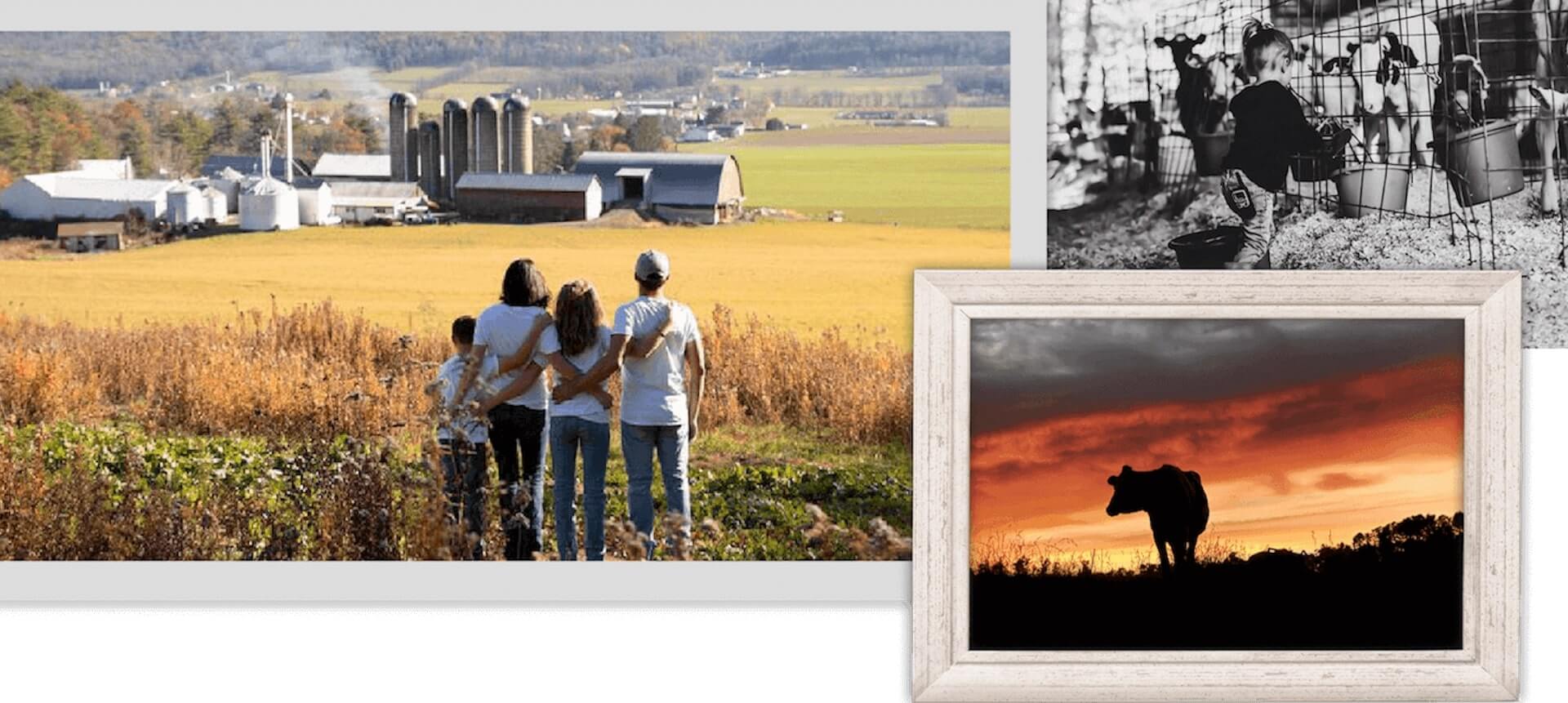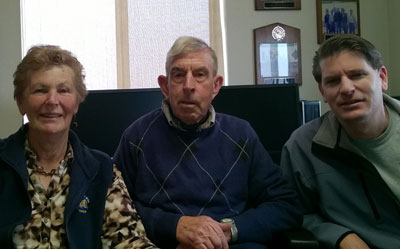
Articles
The Faces of an Infant Dairy Industry
The Nellis Family — Fort Plain, N.Y.
In 1710, William Nellis—along with his brother, sister, mother and father—boarded a ship to escape religious persecution in Dutch Holland.
The journey wasn’t easy. And William’s father, Johannas, did not survive.
When William, his mother, Marie, and his siblings arrived in what would become America, they ventured north through the Hudson Valley to what is now known as the Mohawk Valley of New York.
Many dairies in the Northeastern U.S. were established by some of our nation’s first immigrants, many predating the Revolutionary War period. Such was the case with William and his family, who settled 50 acres and began to raise dairy cattle. Throughout 10 generations, this land has remained in the Nellis family. During a portion of time, chickens were raised. For many generations, dairy cattle have been the primary focus.
In 1983, the ninth generation of the Nellis family took the reigns, as John purchased the farm from his uncle. A year later, he and his wife, Chris, were married. John and Chris have raised three daughters on this land—Katie, Brittany and Erin.
Today, Nellis Acres consists of 100 registered Holstein cows and nearly 200 head of young stock on about 210 acres—120 of which are tillable.
The girls remain an active part of the dairy industry.
Katie, their oldest, raises registered Holsteins with her husband about 20 miles from the family farm. Daughter Brittany returned to Nellis Acres five years ago after graduating from SUNY Morrisville Agricultural and Technical College. And youngest, Erin, plans to return to the farm after she graduates from SUNY Cobleskill Agricultural and Technical College this spring.
“We are working out a transition plan for Brittany and Erin to eventually take over the farm someday,” Chris said.
Family tradition is important to the Nellis family.
“If you walk through my home, you’ll see the last horse-drawn plow our family used, as well as the last ox yoke,” Chris said. “William died in 1785, and we have his last will. So many precious pieces have stood the test of time.”
Even the original deed and patent on the land from 1723 hang in the family home today. And what a story it carries with it, Chris said.
“Legend has it, the Nellis family’s slave hid it in the notch of a tree when the Native Americans burned down the farm in the 1800s,” she recalled.
This pride in the family story and history inspires the Nellis family each day.
“These stories really tell us who we are,” Chris said.
And it’s the driving force for Erin and Brittany to carry on the Nellis farm into the 10th generation, Erin said.
“We want to keep it going—to see it go away would leave us heartbroken,” Erin said. “We wouldn’t just let down our parents if we let it fail. We’d be letting down our ancestors too.”
Plans are underway to celebrate the farm’s 300th birthday in 2023.
“One of the things my husband said when we first started dating: His goal in life was to see the farm still in business and in his name on the Nellis farm’s 300th birthday,” Chris said. “As we get close, it’s even more exciting. We’ve worked together to make it happen.”
The Olson Family — Sturgeon Bay, Wis.
Mathias Olson boarded a ship to America on May 18, 1869, from Norway. He arrived in America a full month later.
“For several years, he rented farms and moved from place to place in Norway,” said great-great grandson Rich Olson. “In his last census in Norway, he had two cows, 20 sheep, 2 acres of oats and 2 acres of potatoes. Then the opportunity arose for him to make a better life in America. So he sold everything he had and left with his wife, his 6-year-old daughter and his 2-yearold son. That month-long trip was certainly not on a cruise ship.”
The upper Midwest was defined by settlers of Scandinavian, Swiss and German descent who brought with them the knowledge of dairy farming and cheese making. The influx of these new skills and knowledge led to a shift from wheat production to dairy production in the 1860s and 1870s in this region.
Mathias and his family fit that mold, as he worked his way across the eastern U.S. and eventually settled in southern Door County, Wis., on 80 acres that the Olson family still farms today.
“My son, Matthias, had an internship in Norway, and we took the opportunity to visit for two weeks,” Rich said. “The similarity between Norway and our farm is incredible. We don’t have the mountains or the steep land, but the climate and abundance of water? It’s almost like they moved their farm from Norway to America.”
Mathias’s pioneering spirit lives on in his great-great grandsons, Rich and his brother, Eric, who became the fifth generation to carry on the dairying legacy on the Door County operation in 1994.
And their willingness to take calculated risks has also been passed through the generations, as well.
“My family has always been early adopters of technology,” Rich said. “My grandfather and his brother were the first ones in the neighborhood to have a tractor with rubber tires. We were the first in our neighborhood to have milking machines. In the late ’70s or early ’80s, we were the first in the county to have a four-wheel-drive tractor. And three years ago, we installed the first milking robot in the county.”
Today, they milk 60 cows on the family farm.
“We aren’t afraid to take calculated risks in making decisions to better our lives—that will make our work easier and make our lives better,” Rich said. “And in every example, the end result was that our life was better because of the decisions made.” The future of Olson Family Farm is not set in stone. But Eric’s children, Luke and Anna, 11; and Zachary, 13, are showing interest in carrying the dairy into the sixth generation. Regardless, the Olsons cherish every day on the farm, living the life that has served their family well for centuries. “We are just happy to continue doing what we love,” Rich said. “For us, there is no better job. Being on this dairy farm, and raising our families in the dairy life? It’s a dream come true. We see the full circle of life—from birth to life to the end. That’s really a humbling process to play a role in.”
The de Jong Family — Escondido, Calif.
A few years later, Jacob and Cornelius Brouwer began the same adventure from Barneveld, Netherlands, with their seven children, boarding a ship for a new future in America, too.

“It was sad, because you were leaving your grandparents and so many cousins to go into the unknown,” Willie, one of the Brouwer daughters, recalled. “Our ship was half freight and half passengers. It was such bad weather, the trip was supposed to be eight days but lasted much longer. When we arrived in the New York harbor, it was so cold— 1 below zero. And then we saw the Statue of Liberty through the mist. I thought, ‘Oh, wow. This is going to be our country now.’ It was truly amazing for me.”
With the influx of settlers to California during the Gold Rush in the 1840s came a growing opportunity to supply settlers with groceries, including dairy products. Thus the California dairy industry was developed and grown.
The arrival of railroads and irrigation led to an increase in dairy production in central California at the end of the 19th century. With it came an increased Dutch and Portuguese influence, including that of the de Jong family.
Because they already had relatives in California, both the de Jong and Brouwer families journeyed across the country by train and settled near Poway, Calif.
John de Jong—one of Arie’s sons—and his siblings initially worked for their uncle and saved their earnings to purchase a farm of their own.
“One day, John’s dad and his brother noticed a little cash-and-carry for sale in Escondido, and that’s how Hollandia Dairy was started,” Willie, who became John’s wife, recalled. “They began by delivering milk to homes, and sales in the beginning were about $8 per day. Then, they began delivering to schools and soldiers on ships in San Diego. Today, the Hollandia Dairy serves many schools. It’s unbelievable, how much it’s grown. Our family has been so blessed—it’s unreal.”
Today, Hollandia Dairy is one of the oldest independent producer and distributor dairies in California.
The de Jong family legacy has spread across the country, and the family is making its mark on the dairy industry nationwide.
John and Willie have two daughters working in the dairy industry in Michigan; a son working in the business in Indiana; and a son and daughter in the business in California.
“It’s wonderful they have been involved,” Willie said. “They are teaching their kids how to work. And it’s so nice to see them keeping our family going in the dairy business.”
As well, the de Jong family now has ties to the dairy industry in Iowa, Arizona, Michigan, Indiana, Wisconsin, California and Oregon.
“John’s siblings have many children, and many own their own dairies all throughout America,” Willie said. “We all worked hard, but that doesn’t always mean the Lord blesses you. We don’t know what we’ve done to deserve it. But we are thankful.”



